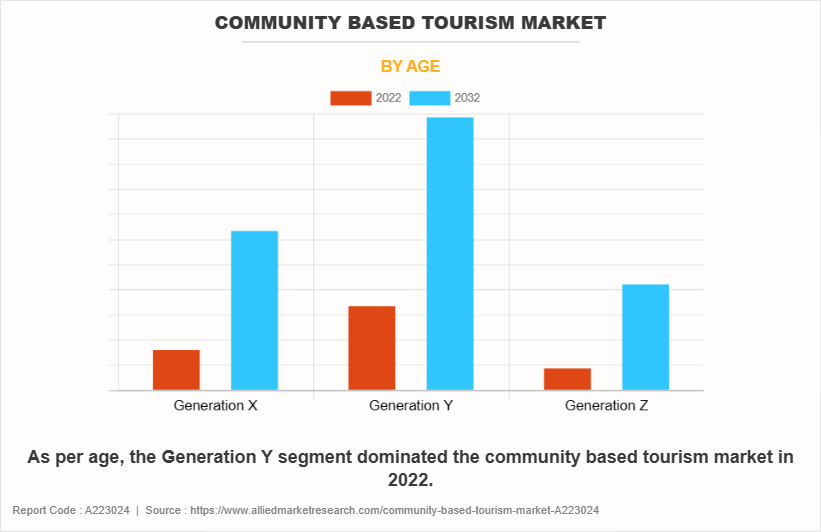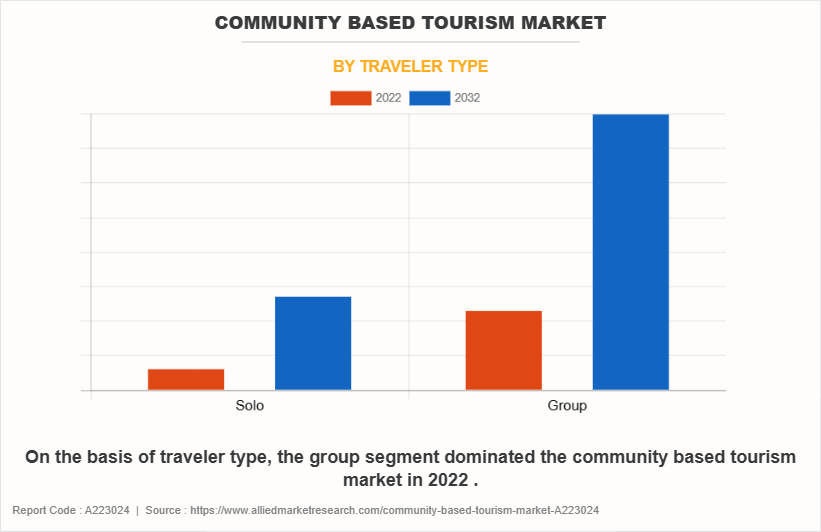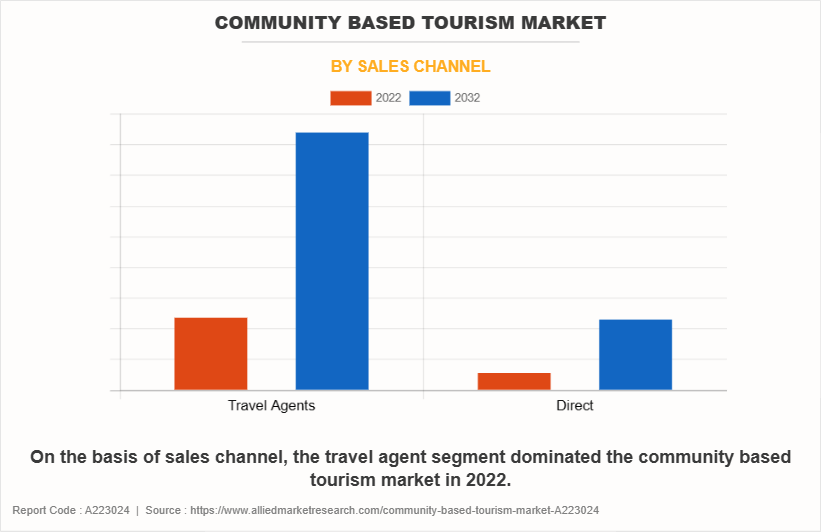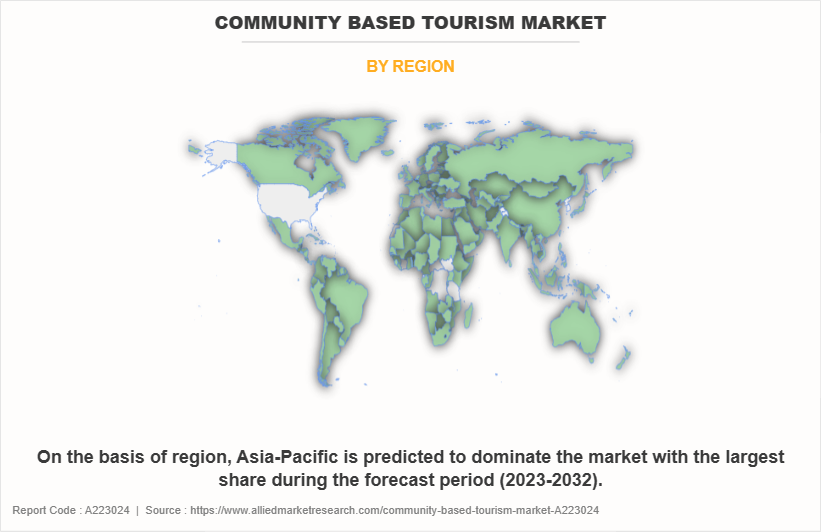Community Based Tourism Market Research, 2032
The global community based tourism market was valued at $575.9 billion in 2022, and is projected to reach $2136.8 billion by 2032, growing at a CAGR of 14.1% from 2023 to 2032. Community based tourism is a type of tourism that is focused on the active involvement and participation of local communities in the planning, development, and management of tourism activities. The aim of community based tourism is to empower local communities, promote sustainable development, and create economic opportunities while preserving and celebrating the cultural and natural heritage of the region. It provides travelers with real insights into local lives and ensures that the travel experience provide genuine impact to local people. Moreover, in this type of tourism, local indigenous communities invite people to experience their customs, food, lifestyle, and set of beliefs.

MARKET DYNAMICS
Globally, the need for Community Based Tourism industry has expanded. As the self-sustainable and locally managed economy has grown,the demand for community based tourism has increased as it provide a genuine source of income to local people . Community-based tourism helps local communities become self-sustaining by ensuring that they are solely involved in the decision-making and management of tourism in their area in order to reap financial rewards. In addition, the establishment and expansion of sustainable tourism programs are facilitated by active involvement of communities in the management of their regional economies. The diversification of economic sources of the communities through community-based tourism creates new revenue streams and lessens reliance on existing ones. Furthermore, the money made from community based tourism activities such as lodging, tours, cultural events, and the sale of regional goods helps to raise living standards and strengthen financial security, which eventually boosted the market growth.
Moreover, the increased value placed on local culture preservation and promotion has become a key driver of Community Based Tourism Market (CBT) growth. Communities that place a high priority on preserving and honoring their cultural history frequently reap a number of advantages. In addition, community based tourism programs facilitate localities a stage on which to display their distinctive customs, culture, and artistic expressions. This draws visitors who seek real, immersive experiences. Communities have been encouraged to invest in the preservation of their cultural assets, including historical sites, traditional crafts, and performing arts, in order to protect them for future generations due to the economic benefits offered by the tourism sector. Furthermore, community based tourism has promoted intercultural interchange, which has cultivated a shared understanding of it.
The development of Community Based Tourism Market Size (CBT) is hampered by insufficient support infrastructure. The success of community-based tourism depends on the active involvement and benefit of the surrounding communities, but obstacles to its development include limited transportation options, inadequate lodging, a lack of basic services, poor information dissemination, inadequate training, problems with environmental sustainability, and regulatory restrictions. Moreover, isolated and underserved communities, which frequently lack adequate transportation infrastructure, lodging options, and basic services, are the ones that participate in community-based tourism the most. As a result, tourists become hesitant since they cannot locate hotels that are secure, cozy, and reasonably priced. Inadequate access to basic amenities such as clean water, sanitary conditions, and healthcare has also impacted the success of a trip overall.
The sustainability of community-based tourism businesses continues to be an issue. This is attributed to the depletion of natural resources and harm to local ecosystems caused by travel activities. This has weakened the attractionof tourists and the lack of sustainable environmental practices have raised the hazards associated with communitybased tourism. The number of visitors and the level of market competition have both decreased as a result of this depletion. In addition, the lack of attention paid to social and cultural components of sustainability has frayed links between tourism businesses and nearby communities. For instance, excessive commercialization and cultural insensitivity have sparked opposition, protests, or other forms of resistance from local residents, which has negatively impacted the effectiveness of projects for community-based tourism. Furthermore, the operators have been compelled to adhere to the stringent environmental and ethical requirements for tourism operations that have been advocated by regulatory agencies and governments, which has impacted the smooth expansion of the market , thus increasing the Community Based Tourism Market Share.
Sustainable tourism has grown in popularity and is in demand over the past few decades. The paradigm shift in consumer behavior has led to a greater emphasis on sustainability, which has changed product creation as well as marketing and promotion of tourism. Market expansion has resulted from public-private partnerships that have subsidized airlines to far-flung tourist locations, enhanced accessibility, and improved transit capacities. This has created profitable prospects for the regional stakeholders. The government frequently collaborates with private parties to enhance the fortunes of the destinations, thus incraesing the Community Based Tourism Market Demand. For instance, the World Wildlife Fund (WWF), the Namibian government, and private landowners worked together to create the NamibRand Nature Reserve, which covers more than 200,000 hectares of unspoiled desert terrain. Through this relationship, landowner participation and government funding for tourism development have been promoted. In addition, it isexpected to result in several opportunities for long-term sustainability, economic growth, and biodiversity preservation. Such collaborations have the potential to improve and sustainably shape the global community based tourism business and to increase Community Based Tourism Market Forecast.
The community based tourism market is segmented into Traveler Type, Age and Sales Channel.
SEGMENTAL OVERVIEW
The community based tourism market is analyzed on the basis of age, traveler type, sales channel, and region. On the basis of age, it is divided into Generation X, Generation Y, and Generation Z. On the basis of traveler type it is bifurcated into solo and group. On the basis of sales channel, it is bifurcated into travel agents and direct. On the basis of region, it is analyzed across North America, Europe, Asia-Pacific, and LAMEA.
BY AGE

As per age, the Generation Y segment dominated the community based tourism market in 2022 and is anticipated to maintain its dominance throughout the forecast period. Generation X has recently shown a preference for wellness tourism and community-based travel. In addition, people of this age are more inclined to explore local communities and cultures in search of true and meaningful experiences. Moreover, they are at the family life stage and value family vacations. CBT can be a desirable alternative for family travel as it frequently offers a secure and immersive atmosphere for kids to learn about diverse cultures and places. They are the largest generation, and they travel the most frequently each year. Millennials today favor unique experiences over materialistic purchases. In addition, Generation Y is very environmentally sensitive while searching for one-of-a-kind experiences, which is why community-based tourism has become very popular with this group.
BY TRAVELER TYPE

On the basis of traveler type, the group segment dominated the community based tourism market in 2022 and is anticipated to maintain its dominance throughout the forecast period. Owing to the concerns about safety when visiting unknown and new places, tourists prefer to travel in groups. The group can also be a family group, a group of friends, a getaway for a couple, a group of students, a group from a company, a pilgrimage group, a wellness group, or a tour group. Moreover, the reduced costs associated with group travel entice visitors to choose it. In addition, shared experiences and interests help people bond extremely fast. Group travel is significantly more convenient, secure, and cost-effective when compared to individual travel. Group reservations are frequently made concurrently with their trip arrangements, which may include logistics, lodging, and transportation. Furthermore, traveling in a group is more affordable than traveling alone because food, transportation, activities, and lodging expenses are split between the groups.
BY SALES CHANNEL

On the basis of sales channel, the travel agent segment dominated the community based tourism market in 2022 and is anticipated to maintain its dominance throughout the forecast period. The travel agents are leaders in the creation of personalized tours. The companies are seasoned advisors with extensive local knowledge who provide recommendations and first-hand knowledge for creating custom excursions. The operators also collaborate closely with a local representative in the country of destination. In recent years, the trend toward custom tours has expanded, which has raised demand for travel companies and agencies. Since travel agents are professionals in destination research and selection and work with community-based tourism operators to ensure a seamless journey, their demand has expanded in the market for community-based tourism. Furthermore, they commit themselves to educating the visitors about the fundamentals of CBT as well as the customs and expectations of the host society.
BY REGION

On the basis of region, Asia-Pacific is predicted to dominate the market with the largest share during the forecast period (2023-2032). In the market for community-based tourism, Asia-Pacific is both the largest and one of the fastest expanding regions. The presence of a sizable millennial population, along with rise in disposable income and improving infrastructure, has led to significant growth in the market share of outbound tourists from the Asia-Pacific area. Moreover, Asia-Pacific is renowned for its rich cultural diversity and alluring travel locations. The countries with the highest outbound travel concentrations among those with higher household incomes are China, Japan, Australia, and India. Over 73% of all outbound travel is accounted for by households earning more than $10,000 per year, according to data on household income. This might be linked to rapidly expanding economy of the Asia-Pacific region and the influx of new work possibilities. The aforementioned factors have boosted the community based tourism market growth in Asia-Pacific.
COMPETITION ANALYSIS
The major players analyzed for the community based tourism industry include G Adventures, Intrepid Travel, Local Alike, Village Ways, Elevate Destinations, Responsible Travel, Community Homestay Network, The Blue Yonder, Wilderness Travel, and WANDERLUST INDONESIA.
The organizers of community-based tourism (CBT) have enhanced their competitiveness by prioritizing authenticity, sustainability, and local empowerment. They offer travelers immersive, high-quality experiences that enable cultural exchange and a deeper understanding of the destination and make investments in R & D to gain insight into new aspects of tourism. Moreover, education and awareness, as well as active community involvement, are fundamental aspects, ensuring visitors leave with enriched perspectives. In addition, strategies such as effective marketing, unique selling points, and collaborations with stakeholders have been followed to expand market reach. CBT initiatives have differentiated it in the market and appeal to travelers seeking meaningful and authentic journeys by promoting responsible tourism practices, fostering economic development within local communities, and providing memorable and responsible adventures.
The market for community based tourism is anticipated to expand due to a rise in demand for sustainable travel, consumer preference for authenticity, and a shift toward responsible tourism. In addition, factors such as innovation, collaboration, product launch, and expansion is opportunistic for market growth.‐¯
Key Benefits For Stakeholders
- This report provides a quantitative analysis of the market segments, current trends, estimations, and dynamics of the community based tourism market analysis from 2022 to 2032 to identify the prevailing community based tourism market opportunities.
- The market research is offered along with information related to key drivers, restraints, and opportunities.
- Porter's five forces analysis highlights the potency of buyers and suppliers to enable stakeholders make profit-oriented business decisions and strengthen their supplier-buyer network.
- In-depth analysis of the community based tourism market segmentation assists to determine the prevailing market opportunities.
- Major countries in each region are mapped according to their revenue contribution to the global market.
- Market player positioning facilitates benchmarking and provides a clear understanding of the present position of the market players.
- The report includes the analysis of the regional as well as global community based tourism market trends, key players, market segments, application areas, and market growth strategies.
Community Based Tourism Market Report Highlights
| Aspects | Details |
| Market Size By 2032 | USD 2136.8 billion |
| Growth Rate | CAGR of 14.1% |
| Forecast period | 2022 - 2032 |
| Report Pages | 290 |
| By Traveler Type |
|
| By Age |
|
| By Sales Channel |
|
| By Region |
|
| Key Market Players | Intrepid Travel, The Blue Yonder, Responsible Travel, WANDERLUST INDONESIA, Elevate Destination, G Adventures, Community Homestay Network, Village Ways, Wilderness Travel, Local Alike |
Analyst Review
Travelers nowadays have opted for unique and exotic holiday destinations, to get away from the daily hectic schedule and gain valuable experiences. Pristine, quiet, serene, and exotic locations are the major factors that people consider while choosing their travel location. As a result, natural and unadulterated destinations with authentic culture are gaining high traction among travelers, especially among millennials. The growth in tourism industry has exerted high pressure on natural resources and experience. As a result, focus on maintaining environmental integrity and developing community based tourism in an ecologically sustainable manner remains a priority for the engaged stakeholders.
Various initiatives by governments for facilitating tourist access and improving the destination experience are in place in order to promote and expand community based tourism. PPPs can be an effective tool for tourism product enhancement and development, along with research, promotion, and marketing. From social collaboration to major infrastructure and development projects, public-private partnerships can play a vital role in transforming community based tourism.
The company profile has been selected on the basis of revenue, product offerings, and market penetration.
Asia-Pacific holds the maximum market share of the Community based tourism market.
The market value of the Community based tourism market in 2022 was $ 608,850 million.
The major players analyzed for the community based tourism industry include G Adventures, Intrepid Travel, Local Alike, Village Ways, Elevate Destinations, Responsible Travel, Community Homestay Network, The Blue Yonder, Wilderness Travel, and WANDERLUST INDONESIA.
The base year calculated in the Community based tourism market report is 2022.
The group segment is the most influential segment in the Community based tourism market report.
The forecast period in the Community based tourism market report is 2023 to 2032.
Asia-Pacific holds the maximum market share of the Community based tourism market.
Loading Table Of Content...
Loading Research Methodology...



